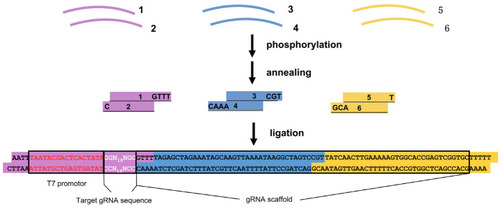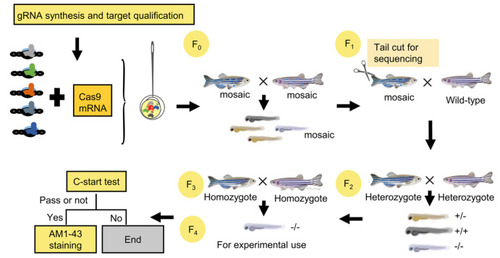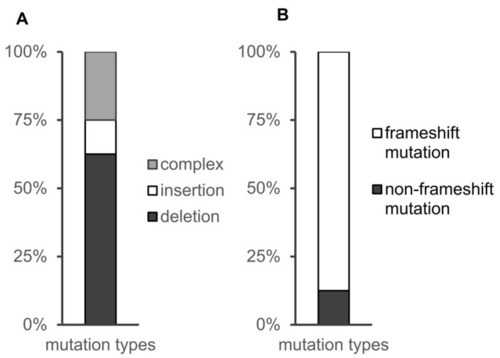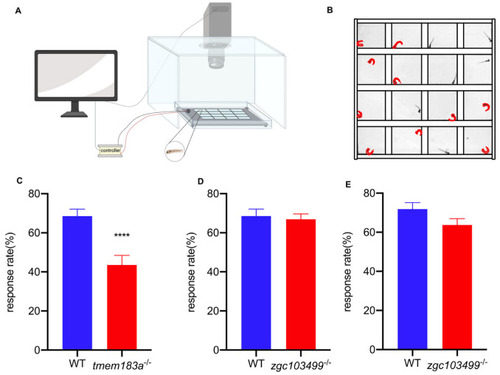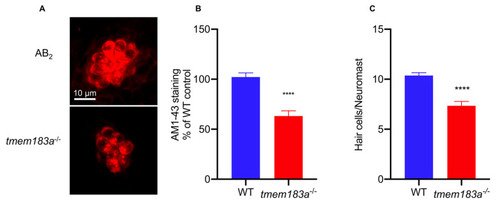- Title
-
Multiplexed Genome Editing for Efficient Phenotypic Screening in Zebrafish
- Authors
- Guo, S., Gao, G., Zhang, C., Peng, G.
- Source
- Full text @ Vet Sci
|
A schematic diagram of generating gRNA templates. Each template contains the T7 promotor, a gene-specific gRNA target, and a common gRNA scaffold. The template is synthesized by ligating three fragments together (in purple, blue, and yellow color), which are annealed from six chemically synthesised oligonucleotides (1–6). The sequences of the overhangs of these three annealed fragments are shown. White letters in the purple fragment designate the gRNA target sequence. |
|
An overview of multiple-gene knockout technology and the generation of individual homozygous mutants. Cas9 mRNA and five gRNAs were synthesized and co-injected into 1–2 cell stage embryos of wild-type zebrafish. Mosaic F0 were in-crossed to generate mosaic F1 zebrafish. Then, F1 fish were out-crossed with wild-type to generate F2 fish. The gene mutation results of mosaic F1 were identified by sequencing. Heterozygous F3 zebrafish were crossed to generate homozygous mutants. |
|
The mutations were classified into different types. (A) Comparison of the types of mutations. The mutations were classified in three different groups: deletions, insertions, and complex (at least one deletion and at least one insertion). (B) Comparison of the types of mutations detected by sequencing. The mutations were classified in two different groups: frameshift mutation(change the reading frame) and non-frameshift mutation. |
|
C-start response in tmem183a- and zgc103499-deficient zebrafish larva: (A) a diagram of the C-start experimental apparatus. A transparent plastic plate was placed on top of a light screen, which was vibrated by an oscillator. Each well was filled with 150 µL embryo medium and one zebrafish larva. The responses of 16 zebrafish were recorded in one session; (B) the representative frame of the C-start response in zebrafish; (C) the mean response rate of tmem183a-deficient zebrafish at 5 dpf. N(wild-type) = 48, N(tmem183a-/-) = 48, ****: p < 0.0001; (D) the mean response rate of zgc103499-/- zebrafish at 5 dpf. N(wild-type) = 48, N(zgc103499-/-) = 48, ns; (E) the mean response rate in zgc103499-/-zebrafish at 8 dpf. N(wild-type) = 48, N(zgc103499-/-) = 48, ns. |
|
The tmem183a mutation impaired the hair cells of zebrafish: (A) confocal microscopic analysis of the hair cells in wild-type and tmem183a-KO zebrafish at 5 dpf; (B) quantification of the staining intensity of hair cell clusters at 5 dpf (for triplicate experiments). N(wild-type) = 32, N(tmem183a mutant) = 35, ****: p < 0.0001; (C) quantification of hair cell clusters at 5 dpf. N(wild-type) = 33, N(tmem183a mutant) = 38, ****: p < 0.0001. |

